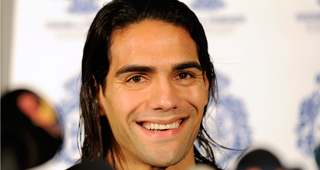Falcao’s penalty miss against Tottenham in a Champions League match last month was an appropriate summary for his two seasons in England. On loan at Manchester United and Chelsea for 2015 and 2016, respectively, he scored just five goals in 36 league matches - which included this single highlight goal reel from him time in London. Beyond the lack of goals, it was the lackluster performances from the once feared striker that perhaps signaled the end of the then 29 year old at the highest level. Yet with seven goals in 10 league matches and 11 goals in 15 matches overall, Falcao’s rebirth season includes leading the most prolific goal scoring side in the top five European leagues at Monaco.
The criticism of the past two seasons was unfair to Falcao, who was still recovering from his attempt to rush back from an ACL injury to play for Colombia in the 2014 World Cup. The instability of Manchester United and Chelsea experiencing transition phases under Louis van Gaal and Jose Mourinho did not help his cause. Diego Maradona criticized Van Gaal in his treatment of the striker during the 2015 season, but the public damage was done. His four goals combined with an expensive salary made him an easy target for “Worst Signing of the Year” lists. In signing Falcao on loan the following summer, Mourinho noted his pain in how the Colombian was perceived by the English public. And that was before his one goal follow up season.
Mourinho certainly had a point. At some point during his time at Atletico Madrid between the 2011 and 2013 season, Falcao was the most feared pure striker in the world. His 52 goals in 68 La Liga matches spoke for itself. Reunited with manager Diego Simeone (the duo won a league title at River Plate in 2008), Falcao was tasked with replacing the beloved Sergio Aguero. Falcao played a significant role in Simeone’s initial phase of transforming Atleti. The duo translated their winning to Spain, taking home the Europa League in 2012 and the 2013 Copa Del Rey.
Falcao’s transfer to Monaco the summer before the 2014 World Cup brought to the fore another aspect of the footballing world during that period. Third parties, in this case Doyen Sports, influenced transfers as much as teams and players. With the club in debt, Atleti (and Doyen) cashed in on Falcao. On Monaco’s end, that summer 2013 transfer window represented an era where billionaire owners attempted to transform modest teams into European powers overnight. Backed by Dmitry Rybolovlev, the changes in Monaco’s roster since that summer reflects both the boom and its subsequent bust. In addition to Falcao, Monaco brought in James Rodriguez and Joao Moutinho from Porto, Geoffrey Kondogbia, Eric Abidal, Ricardo Carvalho, and Anthony Martial. There must be more efficient ways of spending $160 million in a two-month span.
------
Currently in second place in Ligue 1, Monaco have scored 49 goals this season, 19 more than the second highest scoring team. In October alone, they scored seven against Metz and six against Montpellier. They added six against Nancy and four more versus Marseille a month later. Falcao and Guido Carillo lead the side with seven goals each; midfielder Thomas Lemar has six more and forward Valere Germain and defender Fabinho round out the attack with five goals each. Monaco gets goals from every position on the field.
It is a change from the side that manager Leonardo Jardim inherited. If Falcao’s career contains the DNA of bygone soccer eras, then Jardim’s time at Monaco includes its own imprinted story. The manager took over the post-boom era of Monaco’s squad in 2014, with Falcao and James having left that summer. Yet there were traces of the past, with Kondogbia, Moutinho, Carvalho and Jeremy Toulalan making up the spine of that initial side. Jardim oversaw a new, fiscally responsible approach that treated Monaco not as a super club but more as a developmental club with deep pockets.
Similar to Fernando Santos and true to Portuguese managerial pragmatics (they both at one point managed Olympiacos), Monaco gave up the fewest goals in Ligue 1 in Jardim’s debut season. Their 3-1 win against Arsenal in the Champions League round of 16 was a defining win for his counter attacking style. Yet true to a pragmatists’ form, his sides were criticized for being boring if effective. And that was before they sold wingers Yannick Carrasco and Anthony Martial the following summer.
Jardim’s tactical growth is as much part of Monaco’s success as Falcao’s resurgence in goals. Monaco still relies upon on a 4-2-3-1 formation for defensive structure in Champions League, but have added a 4-4-2 formation in league play with Valere Germain playing alongside the Colombian. Traditionally playing as a lone striker, the partnership added an extra wrinkle to Falcao’s game. Germain focuses on the running, Falcao on attacking the penalty area. The twist in formation also represents the striker readjusting to his age and his knee injury and doing what he does best: score goals. If Monaco’s approach in Champions League two seasons ago was to defend and counterattack, they may just try to outscore opponents this time around.
After Alexis Sanchez’s recent hat trick against West Ham, Arsene Wenger once again reminded us about the quality of South American strikers. In another example of how quickly soccer moves, Falcao would have topped this list just three years ago. As much as it hurts Mourinho, his most dynamic days are behind him due to age and injury. Falcao certainly has the respect of his peers and managers ranging from Gabi to Pep Guardiola. The Champions League knockout stages represent Falcao’s opportunity to work his way back in the minds of supporters who never got to see his best. And it may even lead Monaco to becoming a European power, three years later.



